By Christopher R. Bartocci
The SIG Sauer name is predominant with the finest military grade pistols in the world and can be found in the hands of some of the most elite military units the world over. They have also been on the forefront of cartridge development with the joint effort with Federal in releasing the .357 SIG cartridge. Although some may not know it, SIG was one of the pioneers of the development of the double/single action .45 Auto with their P220 pistol chambered in .45 Auto. Over these recent years, SIG has changed the way they make pistols: that is the location as well as some major changes. These include opening a manufacturing facility in the U.S. as well as the introduction of the American made stainless steel 1-piece slide. The U.S. Navy has been a big proponent for SIG pistols with the SEALs adoption of the MK25 P226 pistol as well as several years of procurement of COTS P226 pistols. The U.S. government has limited purchases of the M11 SIG P228 compact pistol.
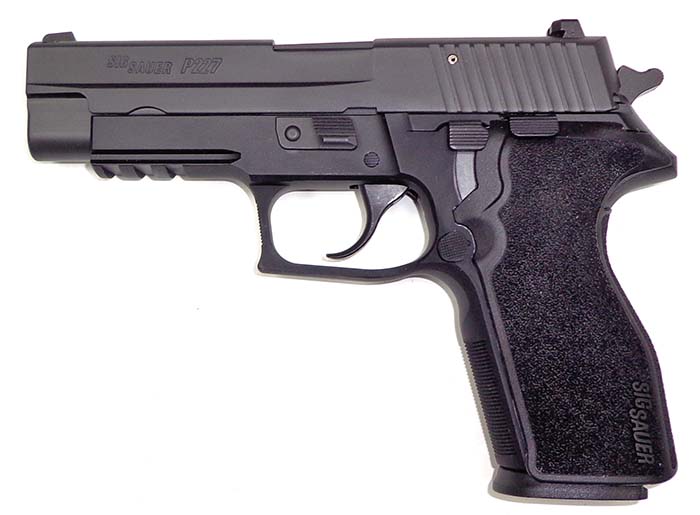
The .45 Auto caliber is simply an American caliber. There are very little sales of this caliber outside of the U.S. commercial, law enforcement and more recently military market. It appears there is a trend throughout the U.S. law enforcement market of the return of the .45 Auto caliber duty pistol retiring the 9x19mm caliber pistols. The .40 caliber pistol still has much popularity but the pendulum has defiantly been swinging in the direction of the .45 Auto caliber. The SIG P220 pistol has been around since the early 1980s in .45 Auto caliber. Originally chambered in numerous calibers including 9x19mm, .38 Super, .30 Luger and .22 Long Rifle, the P220 is now only offered in .45 Auto. The P220 has a 8-round single stack magazine. The pistol operates by the Browning locked breech short-recoil method. When the cartridge is fired both the barrel and the slide are locked. The slide begins to move rearward and the barrel is cammed, sliding the barrel downward to unlock the slide from the barrel. At this point the cartridge case is extracted and ejected from the pistol. Once the slide reaches its full rearward movement the recoil spring returns the slide forward stripping the next round from the magazine, feeding the round and chambering it. At this point the slide moves to its full foreword most position where the barrel and the slide lock up again due to the camming action of the barrel.
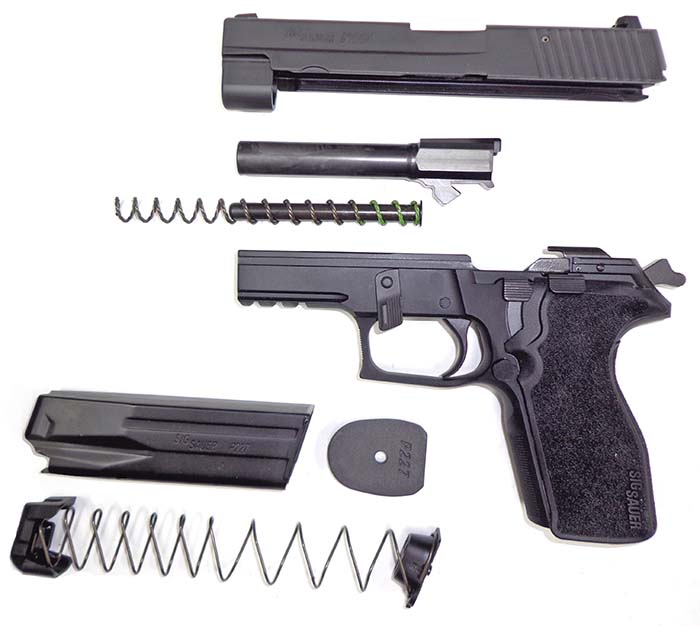
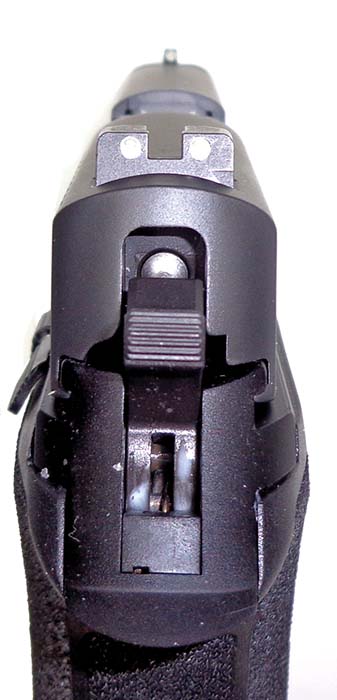
SIG pistols were very simple to operate. They had no manual safety. Looked favorabley by some and a negative by others, the SIG pistols offered a double action/single action trigger pull. Once the pistol was loaded, the hammer was decocked via a decocking lever on the left side of the pistol. To fire, the first pull is a long approximately 10 pound double action trigger. Once the pistol fires all consecutive rounds will be a lighter approximately 4.4 pound single action pull. Of course at any time the decocking lever may be engaged to return the hammer to the double action position. SIG pistols also used a passive firing pin block, which was a major breakthrough in safety. Unlike the GI M1911-type pistols that one could drop on the muzzle with the safety engaged at 5 feet and have an unintentional discharge due to the inertia of the free floating firing pin the SIG P220 could not fire unless the trigger was pulled all the way to the rear. There is a spring loaded plunger in the slide which blocks the forward movement of the firing pin that is disengaged by an arm in the frame when the trigger is pulled all the way to the rear. For a right handed shooter, the magazine release, decocking lever and slide release are all within sweeping distance of the right hand shooters thumb. The pistol is not so friendly for a left handed shooter. Instead of using the slide release the lefty would slingshot the slide by manually pulling it to the rear. He would use his trigger finger to actuate the decocking lever and magazine release.
Maintenance of the pistol is extremely simple. Insure the weapon is unloaded by first removing the magazine. Retract the slide and visually inspect the chamber. Lock the slide to the rear. Rotate the takedown lever and pull the slide assembly off of the front of the frame. Push inward on the rear of the recoil spring guide and lift it out of the slide assembly. Now lift upward on the barrel and remove it from the slide.
The P220 fared well with law enforcement and commercial sales, but the low magazine capacity could not compete with the new generation of 9x19mm caliber pistols that would soon dominate the industry. In the U.S., with the onset of the war on terror, American special forces began to get into regular engagement with pistols that proved the inferiority of a 9mm ball round compared to a .45 Auto caliber round. Operators liked the light recoil and high capacity but it was soon to be determined that all would change in favor of the stopping power of the .45 Auto. The Glock and H&K pistols would find their way into theater, as well as some of the traditionalists who liked the old and outdated M1911-type pistols.
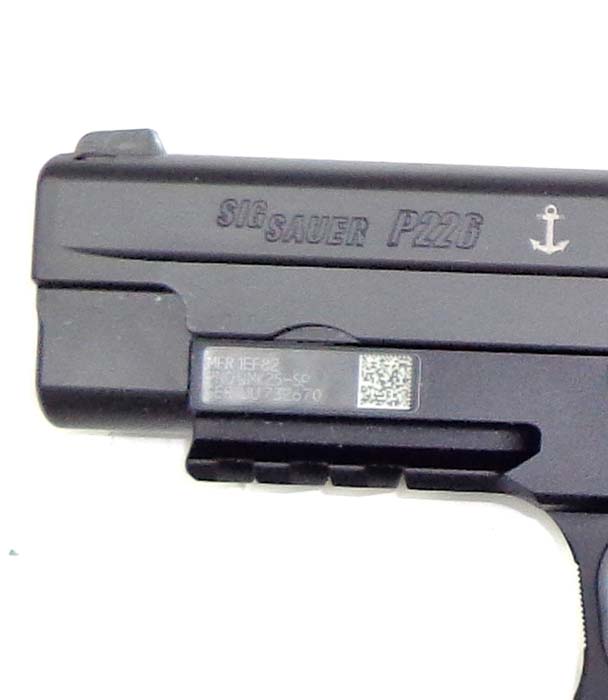
At this time SIG Sauer was behind the ball. They had spent these years developing the P226 in 9mm and the P229 series in 9x19mm, .40 and .357 SIG as well as introducing their own polymer framed pistols. The pistols being procured by the American military and law enforcement in .45 Auto caliber were high capacity pistols ranging from 10 to 13 rounds. That was significantly more than the 8 rounds offered by the P220. The time had come for SIG to enter the combat .45 Auto caliber pistol market. They already had a combat proven pistol with a incredible name and reputation – they only needed a pistol to compete.
At SHOT Show 2013, SIG Sauer introduced a new family of the P-series pistols, one that would fit this need for the .45 Auto caliber combat pistol: the SIG Sauer P227 series of pistols. Three pistols are offered in the P227 family. The P227 Nitron (4.4 inch barrel), Carry (3.9 inch barrel with rail) and SAS Gen II (3.9 inch barrel) without rail. The P227 Nitron is the combat/duty pistol that was sent to SAR for test and evaluation. The other two models are compact versions with shorter barrel length.
The P227 Nitron has very similar dimensions as the P226 chambered in 9mm with the biggest difference being the slightly larger grip. The overall length of the pistol is 7.7 inches and overall height is 5.5 inches, which is identical to the 9mm P226. The width of the pistol is 1.5 inches. The P227 Nitron was equipped with Siglite tritium night sights but could also be had with standard sights. The big change on the P227 from the P220 is the increase from an 8-round to a 10-round magazine. The 10-round magazine is a double column magazine that is easily loaded up to the capacity. Thus, the P227 Nitron can be loaded with 10 rounds in the magazine plus 1 in the chamber for a total of 11 rounds.
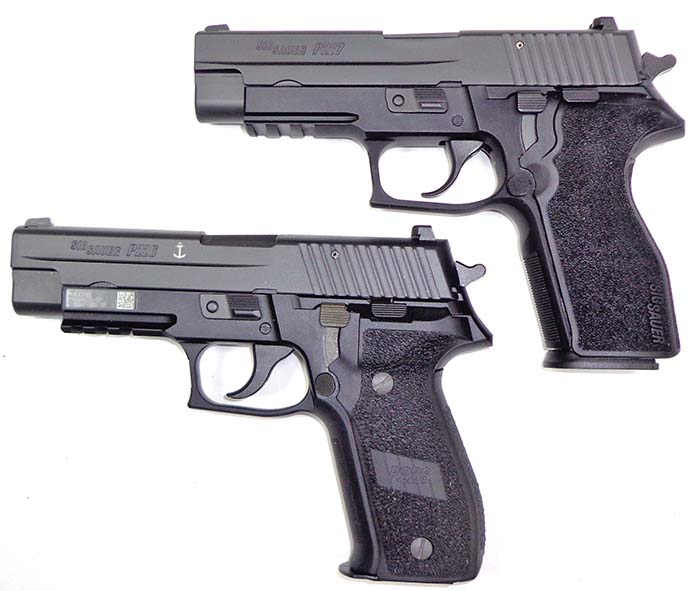
The frame of the P227 has a Mil-Std 1913 rail on the front bottom of the frame allowing attachment of tactical lights or laser sights. The backstrap has a unique shape with a hump on the bottom. This is a very comfortable grip, especially those with large size hands. The stainless steel slide of the pistol was machined flawless, what one would expect from a company with a reputation like SIG. The frame is anodized black and has a nice checkering pattern on the frontstrap of the grip. Slide comes back as smooth as can be and there is no play/rattle between the slide and frame. The test and evaluation trigger broke at 4 3/4 pounds on single action and 10 1/2 pounds on double action.
The first P227 pistols did not leave the factory until summer of 2013 and now they are still quite hard to get. There are many new developments in .45 Auto caliber ammunition such as the Federal HST load as well as the proven Hydra Shok round. Remington has their Golden Saber and Bonded Golden Saber rounds as well as the soon to be released Black Belt Golden Saber rounds. Winchester offers their Politically correct Ranger T-Series (Black Talon design). Hornady offers one of the finest LE defense cartridges called the Hornady Critical Duty and Critical Defense loads. CCI offers their proven Gold Dot ammunition. Some of the specialty ammunition is the Lehigh Defense Controlled Fracturing and Maximum Expansion loads.
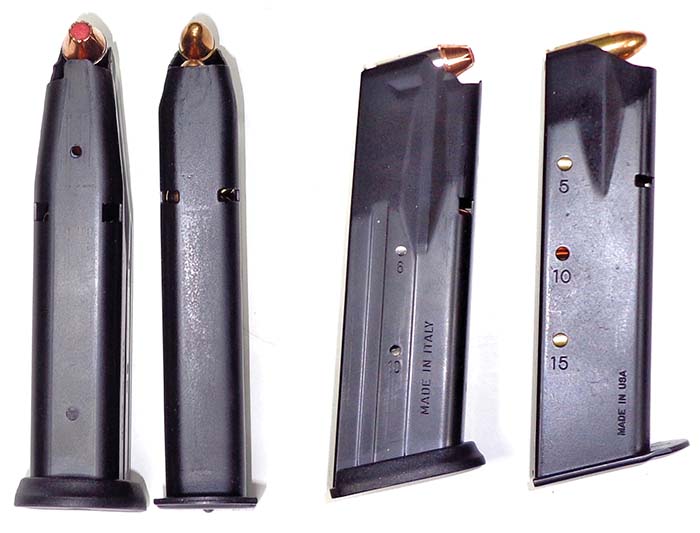
The test and evaluation pistol was tested with Pierce Ammunition 230 grain full metal jacket for function testing. There was a total of 200 rounds of Pierce 230 grain full metal jacket round nose fired in the P227 with no malfunctions. The ball ammunition shot consistent 2-inches at 15 yards from a supported position. One magazine of 10-rounds was fired in the Hornady Critical Duty, Federal HST, Federal Hydra Shok, Remington Golden Saber, CCI Gold Dot and Winchester T-Series. There were no malfunctions. The P227 fed all these different high performance hollow point rounds with no malfunctions making this a very reliable pistol regardless of what it is fed in high quality ammunition. The best group was with the Critical Duty 220 grain FlexLock cartridge with 1 3/4 inch group off hand at 15 yards.
The P227 will definitely be competing for military contracts. It will be interesting to see how the P227 is received by SOCOM who has always favored the 9x19mm P226. Although in recent years they had switched to guns in .45 Auto such as Glock and Heckler & Koch pistols. The P227 will give them everything they liked and had coveted in the P226 but fire the projectile they have come to respect on the battlefields of Iraq and Afghanistan. It seems logical that they could switch to the P227 with little to no transition training. The pistol will certainly have interest in law enforcement. The compact versions will fare well for both LE and commercial sales for personal protection and undercover weapons. The major hurdle will be the same as it has been throughout the history of SIG: cost. The high price tag of SIG pistols have taken them right out of police procurement trials compared to their contemporaries. But it is difficult if not impossible to make a fine quality handgun on the cheap. You will get what you pay for.
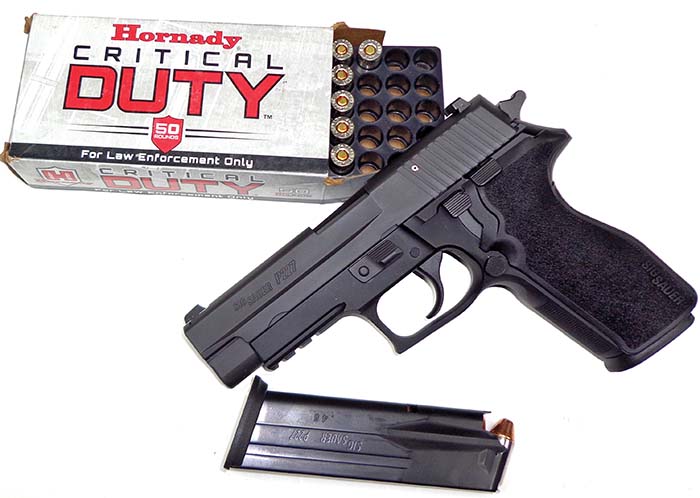
| This article first appeared in Small Arms Review V18N3 (June 2014) |












